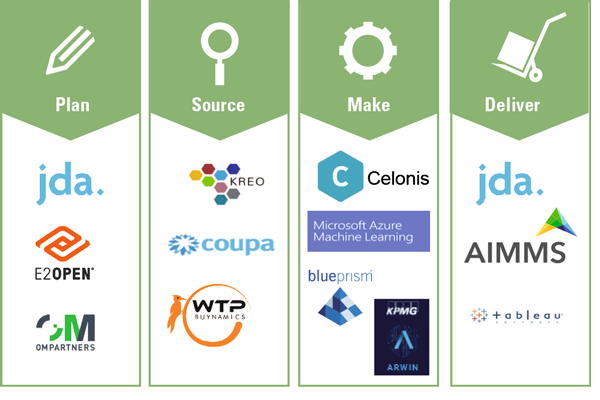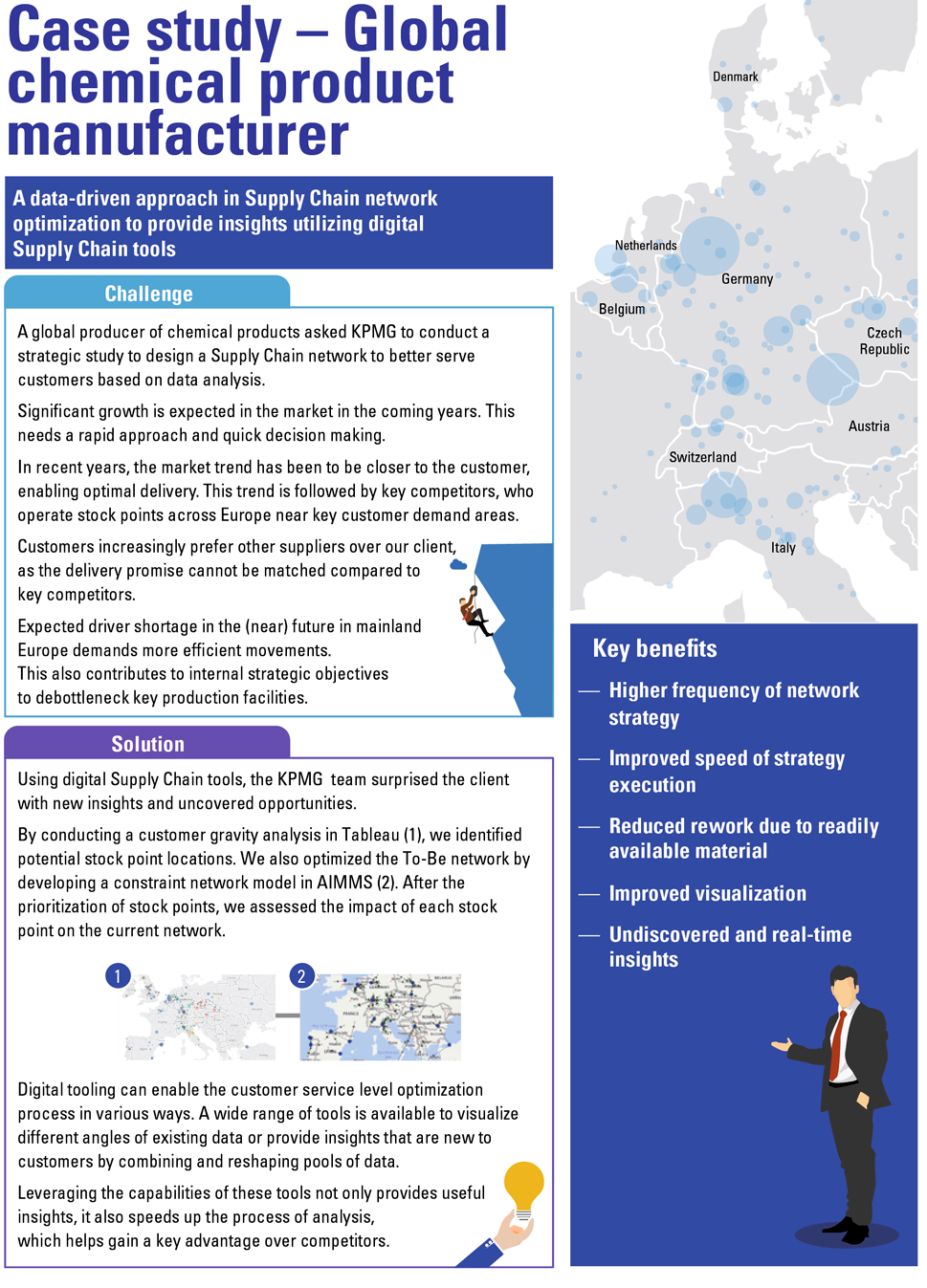The deployment of technology to manage workflows and capture data is becoming mainstream and will continue to intensify over the next few years. Many enterprises have implemented ERP systems to manage various business processes. However, the significant amount of data recorded by these systems is not yet fully used to drive dynamic decision making. Digital technology has now become affordable for both small and medium sized companies, as well as big enterprises. This helps them enhance productivity and business gain by adding data-driven visibility and making strategic decisions.
Introducing digital solutions to solve some of the most common supply chain issues can help organizations not only reduce costs, but also uncover growth opportunities, enabling new business models.
Introduction
Industries all around the world have entered a new era which is driven by technology adoption. ERP (Enterprise Resource Planning) systems have been managing the various business processes for quite some time now, which means that large amount of data is recorded in the core systems. New technological developments such as supply chain systems or business intelligence and data handling systems that use ERP systems as a foundation – that were not available earlier – can now be used to drive dynamic decision making.
Competition across the value chain segments of supply chains has intensified due to the abundance of capital and resources along with the rapid development of competition from and to emerging markets. Heightened competition has led to an increase of customer expectation thereby requiring companies to become more customer-centric to remain competitive. The transition for B2B (Business to Business) is further accelerated by the lightning speed of technological change experienced in the B2C (Business to Customer) sector, which creates a high service expectation among B2B customers and puts pressure on supply chain costs.
New technologies are therefore forcing companies to transform their business models, and globalization is extending commercial networks, requiring a larger footprint for companies. These changes in business models are significantly impacting companies’ supply chains, creating a need to reconsider the way they partner with third party suppliers for example. (E.g. A company may need to find and integrate a new haulier provider in their to-be situation due to a new customer-centric business model they adopted.)
A modern, digitized supply chain is therefore a clear answer to these challenges. Introducing new solutions can help organizations overcome not only the most common supply chain issues to reduce costs, but also uncover growth opportunities. This is especially true for technology-conservative companies which have been slower with technology adoption.
A transformation strategy is needed to proactively manage this change. Enough resources need to be earmarked and many companies are lagging in this respect. Leading companies are already taking advantage of digital transformation ([KPMG17]).
In this article we will look at the changing landscape and reflect on recent challenges and cases of different mid-size companies that are navigating the process of digitizing their supply chains.
Trends driving the change
1. Building a more ‘customer-centric experience’
The explosive growth of global e-commerce has increased customer expectations. Just a few years ago, same-day delivery for consumer goods was unimaginable, yet today this service is standard in several markets with next-day delivery becoming a norm. Furthermore, B2C e-commerce companies have enhanced their processes to absorb the increased shipping costs rather than passing them on to the consumer.
B2B businesses have seen a wider range of adoption. At one end of the spectrum we have businesses which work in manufacturing clusters with just-in-time (JIT) deliveries, yet at the other end of the spectrum we have business which are make-to-order and can take several weeks and months to deliver to the needs of customers. Slowly but steadily, delivery promise and shorter lead times are becoming very relevant for success for B2B business.
Example: A B2B chemical business operating in Europe wanted to increase the OTIF (On Time In Full) from 90% to 95% and the delivery time from 7 days to 2 days. This was enabled with zero cost increase, by using Supply Chain digital tools and data available to optimize processes.
B2B businesses are starting to follow the example set by B2C by determining strategic product locations and the ideal number of warehouses to best serve customers’ needs. This includes companies looking to win and retain B2B customers by offering the same level of service that B2C retailers provide. This is enabled by new software and tools enabling short cycle strategizing, real time planning and dynamic supplier collaboration.
2. New business models enabled by digitalization of business
The value chains are changing with the appearance of new players on the market and changing access to the end customer. We see this when firms try to open a new business replacing an incumbent. This is exacerbated by players from emerging markets, and by e-commerce firms disrupting the traditional supply chains demand and delivery points. Omni-channel business strategies are now the norm for all businesses, be it B2B or B2C.
Example: A bed retailer was the sole access point to a customer ten years back, but now the customer can choose to go to a shop or visit an e-commerce platform. In the latter the suppliers of the retail store are directly competing with the bedding company. With the overall population being constant and sales of beds in the economy being stable, there is an increasing competition to capture value pockets by new business models.
Companies are looking at new business models and services to enhance their current offerings. Emerging digital business models, e.g. Omni-channel, Subscription, Servitization (shift from selling product to selling an integrated product and service offering ([Bain09])) etc., require the companies to change their operating model and their supply chain networks. In addition, there is also a need to drive new collaborations with supply chain partners to ensure delivery of the new business models.
Recent advancements in digital technology offer unprecedented levels of connectivity, granularity, and speed in accessing, processing, and analyzing huge amounts of data ([Guer18]). We are now beginning to see a steep change in performance and outcomes achieved by companies enabling them to achieve operating profit expansion.
B2B supply chains are evolving from a cost-focused organization to a revenue- and top line-enabling organization.
Digital solutions to transform supply chains
Supply chain digital transformation is one of those megatrends, affecting small and medium-sized companies as well as big enterprises. For big enterprises, digitization is already a way of life and now it is time for small and medium size businesses to jump on board and start using digital technologies in order to get benefits in the supply chain and catch up with these big enterprises to outperform the competition.
There are many technologies impacting the supply chain area from core systems, such as Enterprise Resource Planning (ERP), Transportation Management Systems (TMS) to decision and interaction tools to drive analytics, collaboration and visualization. Along with the Internet of Things (IoT), robotics (RPA) and Artificial Intelligence (AI), this offers opportunities to facilitate growth by lowering the cost of current (or future) services.
These tools can help companies optimize supply chains, meet customer demand, successfully expand to emerging markets, and get an edge over the competition. How are these tools used in supply chain optimization?
An optimized supply chain provides new opportunities to small and medium-sized companies, including a greater range of products and service offerings that target different customer segments as a result of greater delivery accuracy and a more strategic location.
There are core solutions like SAP ERP and Oracle ERP that have been used for many years now. These solutions helped streamline processes and created a huge amount of data, which was not fully used until now. Nowadays, in the age of new technologies, it is highly important to find the right tools to improve decision making. Figure 1 indicates some of the examples that we have seen at our clients. Using the right tools in combination with understanding the demand will lead to real value.
Figure 1. Software options that might be considered when building a digital supply chain solution. [Click on the image for a larger image]
Example 1: The implementation of a TMS system ensures real-time visibility of inventory and improves collaboration with suppliers and customers. TMS enables visibility for analysis of costs and performance measurement to uncover areas for improvement and helps optimize shipments (Less than full Track Load (LTL) vs. Full Truck Load (FTL)).
Example 2: AI optimizes logistics operations through smart robots that receive, assemble and ship customer orders. Using real-time sales data, AI can also predict likely future orders and deploy robots to the determined distribution center. This improves delivery times and reduces the need for human input in the supply chain, which increases safety, efficiency and transparency ([KPMG19]).
Figure 2 illustrates our observation that data exists in multiple pockets, but with good data management tools at our disposal and limited data effort (weeks instead of months) these tools can be run on a standalone basis to unlock significant value.
Figure 2. Driving insights using technology has become easier and cheaper for smaller teams and organizations. [Click on the image for a larger image]
A differentiated approach to supply chain network design
The traditional supply chain network positioned their manufacturing and shipping centers in the most cost-efficient areas to gain a competitive advantage. Today, the shift towards customer centricity encourages companies to optimize their supply chains by creating regional ecosystems, and a key factor will be the establishment of end-to-end supply chain integration.
Rather than investing in a single large facility, companies need to create a localized network of smaller outsourced partners. Supply chain network partnerships, especially third-party network providers, help companies leverage necessary resources and manage logistics more effectively. This model provides an optimal service level that promises next-day delivery with a guarantee that every delivery will be supplied on time and in full.
Achieving expedited delivery requires a wide range of tools that can prepare data, visualize different angles on existing data and provide new insights into customer behavior. Leveraging these capabilities allows companies to speed up the process of optimization and receive the benefits. Figure 3 illustrates the benefits of differentiated approach to supply chain network design.
Figure 3. The benefits of differentiated approach to supply chain network design. [Click on the image for a larger image]
Companies that realize these benefits can offer lower prices to customers, operate at lower costs and potentially gain a leading position in the market.
As Figure 4 indicates, supply chain transformation starts with a solid plan that requires you to go through a structured process to visualize the future state, before getting into the detailed design.
Figure 4. A plan to follow when optimizing a supply chain network. [Click on the image for a larger image]
Digital tools also allow companies to perform these assessments on a more frequent basis, ensuring the organization remains nimble in an ever-evolving market.
Figure 5 illustrates the case study for global chemical product manufacturer, their challenge and the solution we identified to address the challenge.
Figure 5. Case study – global chemical products manufacturer. [Click on the image for a larger image]
Conclusion: embrace the supply chain evolution
Over the course of the article we have touched two major trends in a supply chain that are driving changes in the current situation: ‘customer-centric experience’ and ‘new business models enabled by the digitalization of business’. These trends challenge industries and influence the strategic decisions of market leaders. The agile and early adopters of these changes will have a competitive advantage over peers.
Companies survive and thrive on growth, which comes from attracting and retaining customers, as well as entering new markets. Leveraging emerging technologies to digitalize supply chains will help your company keep pace with current trends, which may be possible at zero costs. By driving supply chain optimization, digital transformation can help industries do a lot more for a lot less and generate sustainable growth in the Age of the Customer.
We conclude this article with three key takeaways.
1. Get closer to your demand and supply data
Start using your existing data from core systems by initiating analytical pilots to assess your Supply Chain and make your decisions smarter, faster and easier.
2. Look at new business models and services
Design the future target operating model and supply chain network to evolve from a cost-focused organization to a revenue and top line-enabling organization.
3. Embrace new tools that can give you a step change
Drive adoption of new tools by ensuring you have the right skill sets and enable them with experience from outside to ensure they don’t lose time in the learning curve.
References
[Bain09] T.S. Baines, H.W. Lightfoot, O. Benedettini and J.M. Kay, The servitization of manufacturing, Journal of Manufacturing Technology Management, 2009, https://www.emerald.com/insight/publication/issn/1741-038X/vol/20/iss/5.
[Guer18] Stefan Guertzgen, Four Trends That Will Define The Chemical Industry’s Future, Digitalist Magazine, May 2018, https://www.digitalistmag.com/digital-economy/2018/05/09/4-trends-that-define-chemical-industrys-future-06164831.
[KPMG16] KPMG, Demand-driven supply chain 2.0, KPMG International, May 2016, https://assets.kpmg/content/dam/kpmg/pdf/2016/05/demand-driven-supply-chain.pdf.
[KPMG17] KPMG, Time to Bloom. A study on the digital transformation of the chemical industry, KPMG International, July 2017, https://assets.kpmg/content/dam/kpmg/xx/pdf/2017/07/time-to-bloom.pdf.
[KPMG19] KPMG Advisory, Optimizing the supply chain through digital transformation, Risk & Compliance Magazine, January-March 2019, https://advisory.kpmg.us/content/dam/advisory/en/pdfs/optimizing-supply-chain-digital.pdf.










